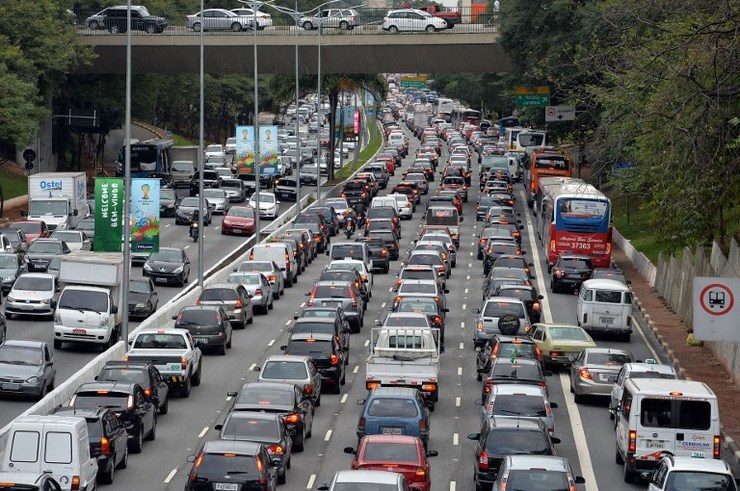SUMMARY
This is AI generated summarization, which may have errors. For context, always refer to the full article.

MONTEVIDEO, Uruguay – Tourists and locals panicked by Latin America’s high crime rates face a far deadlier regional threat, with automobile accidents claiming more lives each year than the region’s notorious underworld.
Whether in Bogota or Caracas, the scene is the same: motorcycles zigzagging between cars like skiers on a fast-paced slope.
“Look,” a Montevideo taxi driver grumbles to himself after speeding through a right turn and nearly plowing down a pedestrian, “she thinks she owns the road.”
The story is the same across Latin America, where crosswalk lights are more decorative than functional, speed limits are ignored, right of way to pedestrians is a myth and traffic lights are disdained.
On Friday, October 31, 14 Jehovah’s Witnesses died in Honduras when a bus ran off the road due to “speed and recklessness,” local authorities said.
And 9 people were killed and more than 39 wounded Sunday, November 2, in two bus accidents on Venezuelan roads.
Such stories are common in Latin American, where in 2013, 16 in 100,000 people died in road accidents, according to the International Automobile Federation (FIA).
In France – a country known for its high rate of deadly accidents – the number fell closer 6.4 deaths per 100,000 people, the World Health Organization (WHO) said in a 2013 report. And in Iceland, the rate was at 0.3 people.
Worst off is the Dominican Republic, with 41.7 deaths per 100,000 residents, according to WHO.
‘Mootoo-taxi!’
Causes for the high rates are many: non-compliance with rules, a proliferation of motorcycles… and general bad habits.
“Why wear a helmet when it’s hot?” Leandro Perillo, an FIA official, told Agence France-Presse in Montevideo.
Bikers shouting “Mootoo-taxi!” weave through traffic in Caracas, where entire families carrying luggage can be seen traveling on one bike – wearing no helmets.
The result? Motorcycle passengers account for 25.73% of Venezuelan road accident deaths, according to the Road Safety Observatory.
The majority of Latin American countries have vastly more road accident deaths than homicides, according to UN statistics on murder, even though crime registers at the top of their populations’ major concerns.
In Uruguay, “it’s more likely that you won’t return home due to a car accident than assault or murder” Pablo Inthamoussu, executive secretary of the country’s National Road Safety Unit, told Agence France-Presse.
Largely considered the safest country in South America, Uruguay’s road accident death rate is 21.5 people per 100,000 residents per year, compared with 7.9 for homicide.
The majority of Latin American countries have vastly more road accident deaths than homicides, according to UN statistics on murder, even though crime registers at the top of their populations’ major concerns
And yet, two out of five Uruguayans said that insecurity is the country’s biggest problem according to the latest report from the Latinobarometro institute.
“The population doesn’t take into consideration the extent of the problem. Road safety is not part of their concept of insecurity,” Inthamoussu said.
Across the region only Mexico, Colombia, Venezuela, Guatemala, El Salvador, Honduras and Panama have more murders than deaths due to road accidents.
Laws exist and can be quite severe in some countries, but they are difficult to enforce.
Cuba, Peru, Colombia and Uruguay are among the countries making the biggest effort to enforce rules and educate the population, reducing tolerance thresholds for drinking and driving and increasing traffic police.
Ravines and old cars
In Lima, buses circulate at breakneck speeds.
“I’m afraid whenever I get in one; we’ve already had multiple accidents,” Victoria Aguilar, a cook, told Agence France-Presse.
And that’s not to mention the cars, coaches and trucks full of passengers that crash in ravines in the Andes in Peru and Bolivia.
Argentina is no exception either: Road accidents are the country’s number one cause of death of people between age one and 32.
“Neither war nor natural disaster is responsible for such tragedy,” said Alberto Silveira, president of the NGO Let’s Fight for Life, which advocates to help prevent traffic accidents.
Meanwhile in Cuba, the problem also lies in an ever-aging fleet of antiquated cars, the majority of which are Lada and Moskvitch models from the Soviet era and older American models from the 1950s.
Ideal for tourist photos, these rusting relics pose just another threat on the road. – Rappler.com
Add a comment
How does this make you feel?
There are no comments yet. Add your comment to start the conversation.